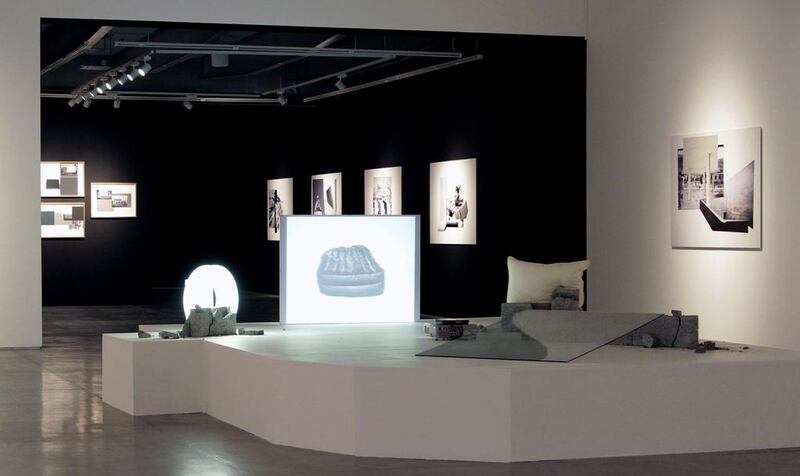In the centre of Dubai's Salsali Private Museum sits Build/Re-build, an installation by the Palestinian artist Hazem Harb.
On top of a platform the same height as a bed, a pillow, a sheet of glass and a ceiling light are supported by concrete blocks, accompanied by a video loop of an airbed being inflated. While the delicate items, intended to recall the architecture of a bedroom, are intact, the concrete is damaged and crumbled.
Upstairs, another video plays in slow motion, showing Harb inflicting the damage with a sledgehammer.
The piece is raw, regionally relevant and timely, particularly in the context of the entire exhibition, The Invisible Landscape and Concrete Futures.
“Concrete is the material of the occupier,” explains Maya El Khalil, director of Athr, the gallery and art institution that represents Harb. “This piece shows the fragility of the occupied but also an awakening – a hope.”
Harb has been working on this series, his first museum show, since 2008. For The Archaeology of Occupation series, Harb has superimposed angular shapes onto landscape photographs. For The Tag Series, he has taken anonymous family portraits, placing squares over faces in the same way that Facebook prompts a user to "tag" or identify people in photos. "Tagging is about recognition of existence," says El Khalil. "Here the artist is talking on behalf of the people saying 'we are here, we are the people of the land'." Also on display is a collection of photomontages made from pre-1948 images of Palestine.
While this show marks a significant point in Harb’s career, it also shows maturity and development for Athr, which started out as a contemporary art gallery in Jeddah but is quickly establishing itself as one of the most important initiatives in the Gulf. “One of our missions is to create dialogue,” El Khalil says. “It is very important for us that we bring to the world a dialogue that originates in Saudi Arabia but that also comes back to Saudi Arabia as well.”
The gallery was founded in 2009 by Mohammed Hafiz and Hamza Serafi, with the initial aim to represent art coming out of Saudi Arabia.
The pair, who took on El Khalil as director right from the start, soon realised that not only were there very few platforms for Saudi art in the region, but there was also very limited infrastructure inside the kingdom itself.
“We began to play many different roles,” she says. “We provided art education, organised workshops and residencies, and connected with institutions abroad to develop an art industry so that our artists could develop their work.”
With no museums, no formal education platforms, not even access to decent art books, artists were forced to travel for exposure and inspiration. Also, if they wanted to produce art, most had to do so overseas, as facilities in Saudi for things like professional printing and framing were not readily available.
Athr immediately began to have a dramatic impact both at home and abroad. It built up a steady roster of Saudi-based talent but also took on international artists such as Harb, a Palestinian who lives and works in Italy and Dubai.
“These relationships are important for local artists as well as for Athr itself,” says El Khalil. “Because, at the end of the day, we believe that art should not have a boundary and even though it can reflect a reality, our realities are very international and the only way to understand each other is to share experience.”
This year, in addition to a strong booth at Art Dubai, Athr was at Art Basel Hong Kong, and Harb’s work, alongside that of Nasser Al Salem and Ahmed Mater, is on display in Museum Villa Stuck in Munich. Mater, who is gaining worldwide renown for his photographs and sculptural work, is also showing at the Kyoto International Festival of Contemporary Culture until May.
“The commercial aspect allows us to survive but the passion of the team is for all the extra work we are doing and the way it is growing beyond that,” says El Khalil. “We feel we have achieved a lot but we know we are really just at the beginning.”
• The Invisible Landscape and Concrete Futures is at Salsali Private Museum, Dubai, until June 6. See www.salsalipm.com for more information. For more on Athr, visit www.athrart.com
aseaman@thenational.ae





